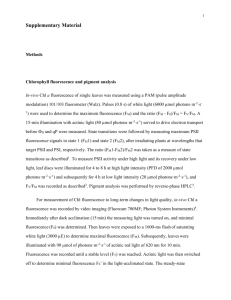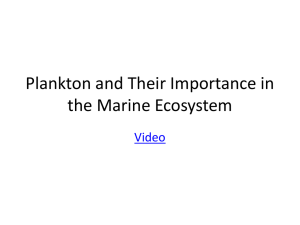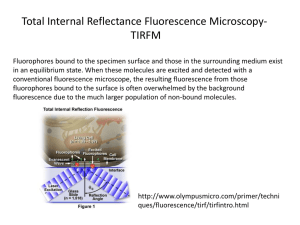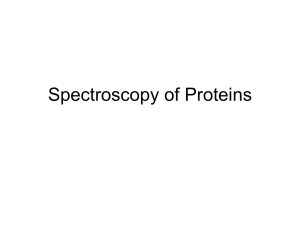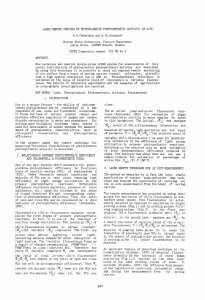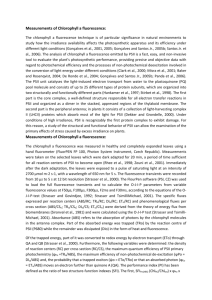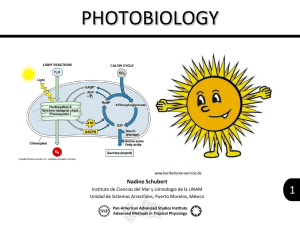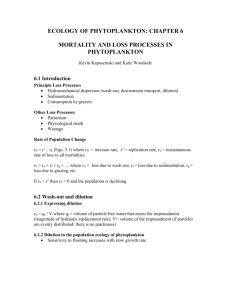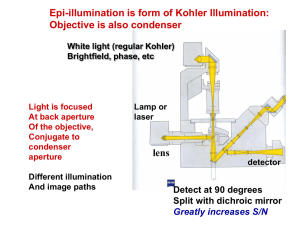to study phytoplankton physiology in optically complex
advertisement
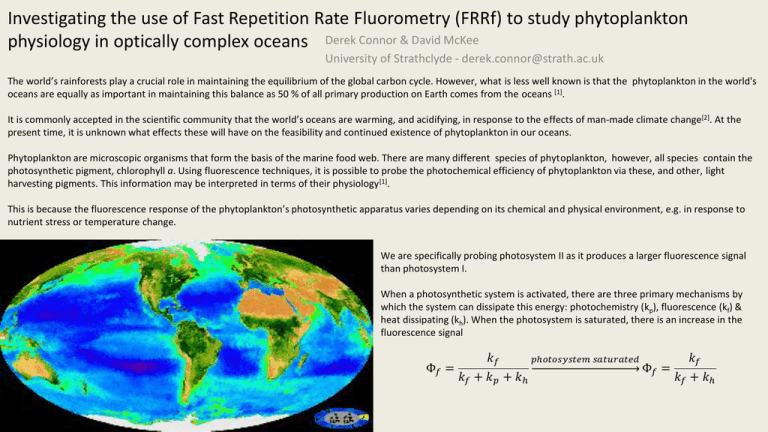
Investigating the use of Fast Repetition Rate Fluorometry (FRRf) to study phytoplankton physiology in optically complex oceans Derek Connor & David McKee University of Strathclyde - derek.connor@strath.ac.uk The world’s rainforests play a crucial role in maintaining the equilibrium of the global carbon cycle. However, what is less well known is that the phytoplankton in the world's oceans are equally as important in maintaining this balance as 50 % of all primary production on Earth comes from the oceans [1]. It is commonly accepted in the scientific community that the world’s oceans are warming, and acidifying, in response to the effects of man-made climate change[2]. At the present time, it is unknown what effects these will have on the feasibility and continued existence of phytoplankton in our oceans. Phytoplankton are microscopic organisms that form the basis of the marine food web. There are many different species of phytoplankton, however, all species contain the photosynthetic pigment, chlorophyll a. Using fluorescence techniques, it is possible to probe the photochemical efficiency of phytoplankton via these, and other, light harvesting pigments. This information may be interpreted in terms of their physiology [1]. This is because the fluorescence response of the phytoplankton’s photosynthetic apparatus varies depending on its chemical and physical environment, e.g. in response to nutrient stress or temperature change. We are specifically probing photosystem II as it produces a larger fluorescence signal than photosystem I. When a photosynthetic system is activated, there are three primary mechanisms by which the system can dissipate this energy: photochemistry (kp), fluorescence (kf) & heat dissipating (kh). When the photosystem is saturated, there is an increase in the fluorescence signal Φ𝑓 = 𝑘𝑓 𝑘𝑓 𝑝ℎ𝑜𝑡𝑜𝑠𝑦𝑠𝑡𝑒𝑚 𝑠𝑎𝑡𝑢𝑟𝑎𝑡𝑒𝑑 Φ𝑓 = 𝑘𝑓 + 𝑘𝑝 + 𝑘ℎ 𝑘𝑓 + 𝑘ℎ Fast Repetition Rate fluorometer: Fast repetition rate fluorometry (FRRf) can be used to gauge phytoplankton physiology. This is done by probing the sample with a train of sub-saturating flashlets which cumulatively saturate the photosystem. The technique measures fluorescence transients (below). Specifically, the instrument measures an initial fluorescence value (Fo) and a maximum fluorescence value (Fm), the difference between these is the variable fluorescence (Fv) . This information allows the photochemical efficiency and absorption cross-section of PSII to be derived. FRRf performs measurements on the microsecond scale meaning dynamic changes in the photosystem, e.g. photoacclimation mechanisms, can be followed. The FastOcean system we are employing is a multi-LED system(450, 530 & 624 nm). This allows us to address the taxonomic problem; this being that different phytoplankton species, despite having chlorophyll a in common, all contain varying concentrations of complementary light harvesting pigments that each absorb and emit radiation at wavelengths other than those for chlorophyll a. Multi-spectral capabilities thereby allow you to probe these pigments more effectively and gain a more accurate picture of the physiological status of the system. We are currently performing a full characterisation of the instrument, the focus of which is to ascertain how well the instrument performs in various water types, e.g. varying concentrations of CDOM, scattering material or phytoplankton concentrations. Other Work: Concurrently, I have been developing a lab-built version of the FRRf . Allows us to independently validate the results produced by the FastOcean system. This system is easily modified and allows for installation of a tuneable supercontinuum laser source. The use of this laser source allows for more intensive study of the taxonomic problem. Initial testing using lab cultures: Phaeodactylum tricornutum, Pseudo nitzschia seriata & Skeletonema marinoi. Future Work: In collaboration with colleagues in my group, we will focus on establishing the relationship between total absorption and absorption cross-sections of PSII. The difference between total and PSII absorption cross-section efficiencies would allow us to probe what fraction of chlorophyll are being utilised for photosynthesis. Additionally, it has been proposed to make direct measurements of the fluorescence lifetime characteristics of phytoplankton. Fluorescence lifetime measurements contain a lot more data than standard fluorescence measurements; helping us gain a better understanding of the effect of taxonomic variability on FRRf outputs. Algal culture experiments will also be conducted in the context of field surveys and controlled lab experiments e.g. HABforming species and other biogeochemically significant species. This also give us the opportunity to fine tune the FastOcean protocols for particular species. References: [1] Field, Behrenfeld, Randerson, Falkowski (1998) Primary Production of the Biosphere: Integrating Terrestrial and Oceanic Components, Science, 281 (5374), 237-240 [2] AAAS Board Statement on Climate Change (2006) [3] Oxborough, Moore, Suggett, Lawson, Chan, Geider (2012) Direct Estimation of Functional PSII reaction centre concentration and PSII electron flux on a volume basis: a new approach to the analysis of FRRF data, Limnology & Oceanography: Methods, 10, 142-154
